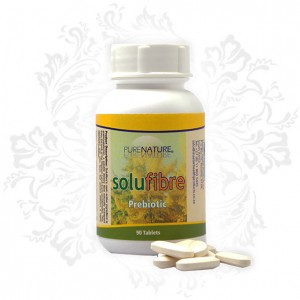A new South African product, Solufibre , is a prebiotic derived from the Larch tree and the Aloe Ferox plant.
FiberAid, the larch arabinogalactan specifically chosen for Solufibre is exclusively manufactured by Lonza Ltd. FiberAid, a soluble fibre, is an accepted premium product with multifunctional properties and when combined
with other products, delivers superior product performance. Blending it with the equally extraordinary attributes of the Aloe Ferox plant has ensured a high standard natural product delivering more than just prebiotic properties.
FiberAid, the prebiotic arabinogalactan, is extracted from the American Larch trees, Larix occidentalis and Larix laricina via a patented method whereby, wood chips are steam heated and the extract evaporated. Because of this natural process, which is free of chemicals, the prebiotic retains its composition throughout the procedure, emerging intact at the end. The uniqueness of the Larch arabinogalactan is its complete solubility, pH stability and resistance to temperature changes.
The larch arabinogalactan is a long, intensely branched non-starch polysaccharide consisting of a galactan backbone supporting chains of galactose and arabinose in a 6:1 ratio. This structure allows the prebiotic to ferment slowly, reducing bloating and gas – a common problem with other prebiotics.
On average, the Larch AG has a carbohydrate range of 85% to 95% and a dietary fibre range of 80% to 90% but due to the manufacturing process, Solufibre has a much higher range for both total carbohydrates (>95%) and total dietary fibre (>90). The use of Solufibre also increases the friendly gut mircoflora Lactobacilli and Bifidobacteria and decreases harmful bacteria such as Clostridia and E.Coli. Increased levels of Lactobacilli and Bifidobacteriareduces the growth of ‘bad’ bacteria, promotes good digestion, enhances the immune system and prevents infections.
Another benefit of the Larch-based prebiotic is its ability to increase the amount of short chain fatty acids (SCFA) in the lower colon and reduce the production of ammonia. Ammonia reduction has a direct influence on liver health, specifically, hepatic encephalopathy which causes disorientation, loss of consciousness and atypical neurological symptoms. The SCFA lower the pH of the gut allowing the development of beneficial bacteria that enhance the following:
- Greater gut absorption of water and salt
- Energy creation for enhanced brain, muscles and heart functioning
- Prevention of cellular differentiation which can cause colonic cancer
- Maintenance of the gastrointestinal mucosa and epithelium
The single stemmed, Aloe Ferox plant can grow over 4m tall, has thorny leaves (thus the name ferox which means ferocious) and can be grown without the aid of pesticides in a number of different habitats, including rocky slopes.
The local inhabitants of South Africa have used Aloe Ferox for centuries to cure various ailments, such as constipation, conjunctivitis, arthritis, asthma, hay fever, irritable bowel syndrome, rashes, insect bites and eczema. It is also an excellent immune boosting supplement and assists with proper digestion. It is only recently, however, that the prebiotic properties of the plant have been discovered.
The arabinogalactan, found deep within the core of the leaf, is extracted using natural processes. After the bitter sap is removed, the high-fibre leaf is then powdered and can be taken orally. The leaf has a content of 43% high dietary fibre of which 1/3 is soluble.
Although Aloe Ferox is not as well known as Aloe Vera, it surpasses Aloe Vera in its offering. Both Aloe Vera and Aloe Ferox offer the following:
- A rich source of nutrients
- Skin soothing properties – e.g. sunburn, rashes, eczema and psoriasis
- Antioxidant vitamins C and E and beta-carotene, which fight damaging free radicals
- Immune system enhancement and maintenance
- Treatment for arthritis and chronic fatigue syndrome
- Management of irritable bowel syndrome
However, Aloe Ferox has a number of therapeutic benefits over and above Aloe Vera. These include:
- A low molecular polysaccharide which acts as a prebiotic
- Three times the amount of polysaccharides which results in greater efficacy in the uptake of iron and calcium and other minerals
- The ability to bind heavy metals such as mercury and eliminate them from the body
- Better digestion and the maintenance of regular bowel movements
- A plant steroid which manages hay fever and asthma
- Finally, another area in which Aloe Ferox far outreaches Aloe Vera is the component aloin. Aloe Vera contains high levels of aloin, which causes bloating and gas, acts as a laxative and destroys skin cells. Therefore, to retain the therapeutic value of the plant, this needs to be extracted using a filtration process. However, the filtration also removes a large amount of nutrients and leaves behind chemicals used in the removal process. Aloe Ferox on the other hand contains only 0.1mg/l of aloin, which has none of the above effects and due to the natural process used for extraction, the product remains intact and clear of harsh chemicals.
Traveller’s Diarrhoea
Traveller’s diarrhoea (TD) affects 11 million people a year regardless of whether they are travelling for pleasure, business or sport. While TD is caused by bacteria and certain viruses, 50% of all TD cases can be attributed to Escherichia coli (E.coli).
Although the generally accepted treatment of antibiotics and anti-diarrhoea medications does reduce the incidence of diarrhoea, 20 -50 % of travellers still suffer from it. These treatments also cause an imbalance in the gut mircroflora and recent studies have indicated that the use of natural preventatives, especially prebiotics, have a much greater impact on averting or healing TD.
A study done by the Department of Food Biosciences, at The University of Reading in the UK showed that the prebiotics prevented the adhesion and invasion of pathogenic bacteria and positively affected the immune function.
The study was set up to be a random, double blind, placebo-controlled study and the participants were all healthy volunteers who were prepared to travel to countries, which had either a high or low risk factor for contracting TD. The results showed that the participants using the prebiotics were less prone to getting diarrhoea and if they were affected the duration was much shorter. This proved that the properties of prebiotics to prevent bad bacteria attaching themselves to the intestinal wall, to boost the immune system and to increase the good bacteria can be considered to reduce the incidence of TD.





